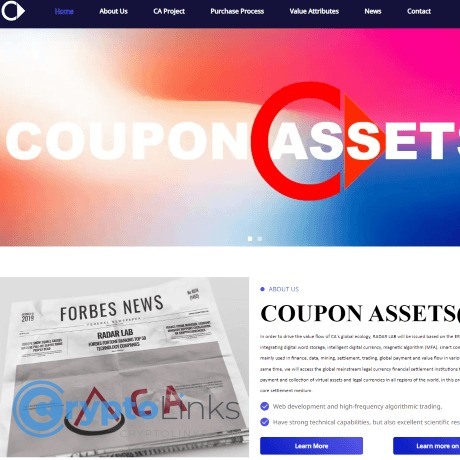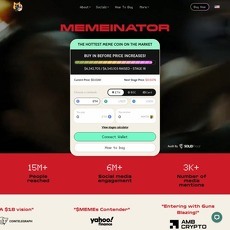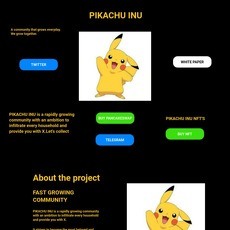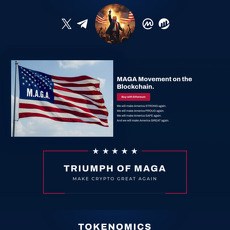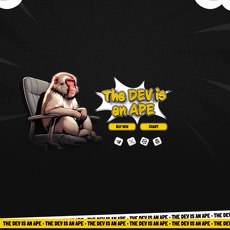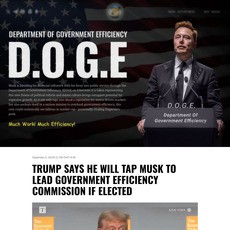Coupon Assets Review
Coupon Assets
radarlab.us
If your website is on the scam list and you think that you are not a scammer, contact us. After you provide us with all the proof that you are in Crypto World with good intentions, we will delist you. Usually, you get in this category because you are hiding your team, you have a bad reputation(you are tricking, deceiving, scamming people), and you haven't got a written project whitepaper or is a shitty one....
Their Official site text:
WhitePaperRADAR LAB • 2023
ContentsChapter I Global Market Background Analysis........................................................................41.1 Current Status of the Global Economic Situation........................................................ 51.2 The Value of Blockchain Technology ...............................................................................81.3 Rapid Development of the Digital Currency Market................................................ 121.4 Market Pain Point Pnalysis ............................................................................................... 14Chapter II CA Project Overview ......................................................................................172.1 Introduction to CA.............................................................................................................. 182.2 RADAR LAB........................................................................................................................... 202.3 Values of CA......................................................................................................................... 222.4 Economic Model of CA......................................................................................................242.5 Value Attributes of CA.......................................................................................................262.6 Future Value Mapping.......................................................................................................28Chapter III Liquidity Models and Value Expansion......................................................303.1 CA Liquidity Model ............................................................................................................. 323.2 LP Pledge Model................................................................................................................. 333.3 Creating a New Hybrid Digital Currency System....................................................... 343.4 Forming a New Credit Formation Mechanism........................................................... 353.5 Co-building a New Scenario Value Chain.................................................................... 363.6 Changing New Payment and Settlement Methods ...................................................38
Chapter IV Technology Package for CA........................................................................ 394.1 CA............................................................................................................................................ 404.2 CA Payment System........................................................................................................... 424.3 Multi-signature Key Management................................................................................. 434.4 Timestamps .......................................................................................................................... 444.5 Distributed Storage............................................................................................................ 464.6 P2P Networks .......................................................................................................................484.7 Supporting Functions Available.....................................................................................50Chapter V Development Route and Planning.............................................................. 53Chapter VI Future Industry Layout ................................................................................ 546.1 CA Cloud................................................................................................................................566.2 CA Charity ............................................................................................................................. 576.3 CA Blockchain Institute..................................................................................................... 586.4 CA Incubator........................................................................................................................ 59Chapter VII Foundation Governance ............................................................................. 607.1 Foundation Overview......................................................................................................... 617.2 Foundation Organizational Structure............................................................................627.3 Governance Principles of the Foundation....................................................................637.4 Risk Assessment and Decision Making.........................................................................64Chapter VIII Disclaimer ....................................................................................................66
ChapterIGlobal Market BackgroundAnalysis
The year 2022 was an extraordinary year for the global economy: the outbreakof the Russia-Ukraine conflict, the sharp rise in energy prices such as natural gas, and the subsequent rise in global inflation levels. To combat rising inflation, thecentral banks of major developed economies, represented by the Federal Reserve, have turned on the interest rate hike mode, and liquidity continues to tighten. Thecentral banks of developed economies have also put the global economy under
significant downward pressure by synchronizing their actions to tighten monetarypolicy. 2023 has ushered in a new beginning for the global economy. But climatechange, counter-globalization, geopolitical risks, supply chain bottlenecks andhighinflation have also become difficulties and challenges that the global economyneeds to face head-on in the process of moving forward. In early 2022, the Russo-Ukrainian conflict broke out, causing a rapid increasein global energy prices and a subsequent surge in global inflation. In response, major central banks of developed economies such as the Federal Reserve, theEuropean Central Bank, and the Bank of England initiated a new round of interest
rate hikes. Throughout the year 2022, the Federal Reserve raised interest rates byacumulative 425 basis points, while the European Central Bank ended its 8-year-longnegative interest rate policy and raised rates by a total of 250 basis points. Furthermore, the Bank of Japan, known for its dovish stance, announcedinDecember 2022 a relaxation of yield curve control, leading to a significant reboundin the persistently weak yen. It is worth noting that the synchronized tighteningof
monetary policies by these central banks of developed economies had a substantial
impact on the global economy as well as financial markets. RADAR LAB believes that there is a lagging impact of monetary policy onthereal economy, and that the dampening effect of monetary tightening on demandmay only just be showing now. The JP Morgan Global Composite andManufacturing Purchasing Managers' Index (PMI) continue to fall into sluggishterritory. Although the 2022 Organization for Economic CooperationandDevelopment (OECD) composite leading indicators fell unilaterally, but only inJulyfell to a level below the end of 2019. International institutions such as theInternational Monetary Fund (IMF), World Bank and OECD are more worriedabout
the economy this year and have recently lowered their global growth expectationsfor 2023, not ruling out the possibility of the global economy falling into recession. Crucially, the fall in demand has not yet significantly curbed global inflation.
Eurozone inflation is still at its peak, with the Consumer Price Index (CPI) reaching10.1% year-on-year in November 2022, and remains skewed to the upside inthefirst quarter of the new year. While the U.S. CPI may have seen an inflectionpoint, service prices remain firm, especially as the "payrolls+prices" spiral has not yet
been broken. Supported by payroll pressure, U.S. core personal consumptionexpenditures (PCE) growth reached 4.7% year-over-year, still far fromreturningtothe Federal Reserve's 2% target. The simultaneous tightening of monetary policies in developed economies hashad a greater impact on the global economy. From the perspective of the real
economy, as global financing costs rise and the economic outlook deteriorates, domestic investment and private consumption in major economies suffer a greater
impact, especially the substantial interest rate hike has a greater impact ontheprivate investment sector, with corporate equipment investment and real estateinvestment under obvious pressure. In the United States, for example, total privateinvestment fell quarter by quarter in 2023, with investment in the second quarter
down 6.1% compared to the first quarter, and residential investment, whichissensitive to interest rates, fell by 12.0%. Private consumption growth is alsogradually slowing down, with goods consumption represented by durable goodsperforming sluggishly. Among numerous central banks in well-developed economies, the Fed'smonetary policy movements are particularly noteworthy. The Fed's aggressiveinterest rate hikes in 2022 have had a big impact on global financial markets. In2022, the negative effects of Fed tightening will be dominated by financial shocks. The world's major stock and bond markets have fallen to varying degrees. Strongdollar output inflation, the maximum increase of the US dollar is more than20%, the sharp depreciation of non-US currencies, coupled with rising commodity prices, significantly increased the imported inflationary pressure of various countries. Inthis context, many central banks have had to follow the Fed in raising interest ratesand tightening. The European Central Bank is a classic example. Even thoughit isclear that monetary policy will not solve the supply-side problem, the ECBis still
forced by imported inflationary pressures caused by the depreciation of the euro, and has to continue to raise interest rates at the risk of worse economic prospects. At the same time, the rapid interest rate hike led to a resurgence of the crisis intheKorean stock and housing markets, forcing the Bank of Korea and the Ministryof
Finance to urgently "bail out". Keeping up with the Fed could lead to excessivetightening in some economies. According to the financial accelerator theory, tightening financial conditions may further increase the downward pressure onthe
subsequent economy. From the perspective of financial markets, on the one hand, the sharpriseininterest rates has led to a rapid rise in bond yields, pressure on bond prices, widening credit spreads, and a rapid rise in corporate financing costs anddebt
burdens. Many emerging economies have seen their sovereign debt risks risedueto the heavy burden of external debt and the reduced coverage of foreign reserveson external debt. On the other hand, against the background of rapid interest ratehikes by the Federal Reserve, overseas capital is rapidly flowing back to the U.S., offshore market dollar liquidity is reduced, the dollar index is sharply higher, non-U.S. currencies are generally under pressure, and emerging economies aregenerally facing financial volatility risks such as exchange rate depreciationandcapital outflows, increasing the degree of volatility in the real economy. Guided by the policy of further increasing support for the real economyinmajor economies, the loan scale continued to grow and the non-performingloanratio decreased compared to the end of 2021. However, under the guidanceof
policies of further increasing support of the real economy in major economies, thescale of loans continued to grow, and comparing with the end of 2021 ,thenon-performing loan ratio decreased. However, under the superpositionof
multiple factors and the repeated impact of the Covid-19, the credit risk andcashflow pressure accumulated in the past still need to be further resolved, and bankingfinancial institutions, non-bank financial institutions and non-financial enterpriseshave all added non-performing assets of a certain scale. In 2023, as far as isconcerned distribution of non-performing asset industries, the industries withmore non-performing assets in the world are mainly concentrated in traditional
industries with overcapacity and industries most seriously affected by Covid-19, from the specific distribution, manufacturing, wholesale and retail trade, leasingand commercial services industry non-performing loan balance andnon-performing rate are at a high level, mining industry and real estate industryalthough the balance of non-performing assets is less, but the non-performingratelevel is relatively high. Facing the downward pressure on the global financial andreal economy, the market needs to further optimize measures to cope withthepossible "black swan" in the future.
The birth of the Internet and mobile broadband has enabled billions of peoplearound the world to access knowledge and information from around the world, enjoy high-fidelity communications, and a wide range of lower-cost, moreconvenient services. Today, these services are available to people in virtually everycorner of the world with a $40 smartphone. Despite this connectivity, a large portion of the world's population is still
stranded. There are still 1.7 billion adults worldwide who are not in touch withthefinancial system and do not have access to the financial services offeredbytraditional banks, and among them, 1 billion people have cell phones andnearly500 million have access to the Internet. For many people, some aspects of thefinancial system are quite similar to the telecommunications networks that existedbefore the Internet was born. Twenty years ago, the average price of sendinga text
message in Europe was 16 euro cents. Today, people with less money are payingmore for financial services, and their hard-earned income is being eroded by fees, such as remittance fees, wire transfer fees, overdraft fees and ATMfees. Blockchain has many unique attributes that can potentially solve a number of
accessibility and trustworthiness problems. These include distributed governance, which ensures that no single entity controls the network; open access, which allowsanyone with an Internet connection to participate; and secure cryptography, whichprotects funds without risk. Blockchain (Blockchain) is a new application model of computer technologysuch as distributed data storage, peer-to-peer transmission, consensus mechanism, and cryptographic algorithm. The so-called consensus mechanismis amathematical algorithm for building trust and acquiring rights between different
nodes in the blockchain system. Blockchain is the underlying technology of Bitcoin, which is like a database ledger that records all transactions. This technology is alsogaining attention from the financial industry and various fields because of itssecurity and convenience. However, existing blockchain systems have not yet
gained widespread adoption, and the lack of scalability and the volatility of digital
currencies have so far led to the poor performance of existing digital currencies interms of both value retention and medium of exchange, thus hinderingtheir
widespread use in the market.
We believe that it is possible to combine the best aspects of blockchain-basedtechnology innovation (distributed governance, open access, and security) withastrong compliance and regulatory framework. Establishing certain compliancerequirements at the protocol layer can improve the effectiveness of programs suchas illegal activity prevention or anti-money laundering (AML), combating terrorist
financing (CFT), and sanctions compliance. Developers, merchants, and consumerscan all benefit from the compliance and security built into crypto networks. Technology innovation in partnership with the financial sector, including regulatorsand experts across industries, is the only way to ensure a sustainable, secureandtrusted support framework for this new system. And this approach can be a major
step toward a lower cost, more accessible and better connected global financial
system. In addition, the decentralized, transaction peer-to-peer and tamper-evident
characteristics possessed by blockchain technology can realize machine trust; theirreversible nature of transactions and information encryption can realize valuetransfer, in addition to peer-to-peer and tamper-evident information canalsorealize smart contracts. • Smart Contracts: refers to the combination of electronic contracts andblockchain technology. When a pre-programmed condition is triggered, the smart
contract executes the corresponding contract terms. • Value Transfer: Realize the value transfer network: value transfer sothat
digital assets can circulate freely on the blockchain; issue tokens (Tokens) tomakefinancing more convenient, while holders enjoy the services of the entire ecology. • Machine Trust: There is no third party central agency on the chain relyingentirely on peer-to-peer, tamper-evident and other transaction mechanisms toensure trust between the two parties. The tamper-evident nature of blockchainchanges the way of centralized credit creation, reducing costs and buildingtrust
through mathematical principles rather than centralized credit institutions. • Token Economy: Passes are negotiable cryptographic digital proofs of
interest, from ID cards to academic diplomas, from currencies to tickets, fromkeysand tickets to points and card vouchers, from stocks to bonds, all proofs of interest
in human society can be represented by passes.
With the rapid development of blockchain and other science and technology, digital currency is gradually becoming a new high point of global competition. Digital currency is cheaper to run than the current paper currency systemandmoreconvenient for long-distance transactions, so it may be widely used in cross-border
payments and global trade in the future. Satoshi Nakamoto first proposed the concept of Bitcoin in 2008 in his article"Bitcoin: A P2P Electronic Cash System", stating that Bitcoin is a decentralizedelectronic cash system based on a P2P network, where both parties to a transactioncan bypass third-party institutions such as central banks and complete transfer
transactions directly through Bitcoin. Bitcoin uses blockchain technology tostoretransaction information in a distributed ledger, and has the superlative features of
decentralization, limited total amount, transaction security, and open information. The emergence of Bitcoin marked the birth of a new era of digital currency, andthepopularity of Bitcoin has driven the research and invention of hundreds of
thousands of digital currencies. After the emergence of Bitcoin, decentralizeddigital currencies entered a large-scale trial phase, and various types of digital
currencies based on different blockchain innovation technologies emergedinlayers. The current digital currency represented by Bitcoin is being widely acceptedfor its advantages such as decentralization, transaction security, and less tampering. The main premise of digital currency is that it is completely decentralized - inother
words, there is no superior entity (such as a state or central bank) that controls itscreation and management. It is enjoyed by the public and governed by the public. This is exactly what Satoshi Nakamoto was trying to achieve when he launchedBitcoin in 2008 - the network would operate autonomously and maintain the value. Bitcoin is the founding coin of digital currencies, but that's just the beginningof the story. With the introduction of ethereum, we ushered in smart contracts, which made possible the decentralized financial industry that thrives today. 1) The Historical Beginning of Bitcoin
The idea of having a digital currency has been around for a long time. Therehave been many attempts to create digital currencies before the advent of digital
currencies, and most of them mainly faced the problem of double payment. Theyhad to ensure that digital assets could only be used once in order to prevent
copying and counterfeiting of digital assets. The concept of digital currency was developed by computer engineer Wei Dai
more than a decade before the advent of digital currency. In 1998, he publishedapaper discussing "B-money" and the idea that digital currency could be sent
through a set of untraceable digital pseudonyms. That same year, blockchainpioneer Nick Szabo took another stab at an idea called Bit Gold, which also sought
to create a decentralized digital currency, inspired by the inefficiencies of thetraditional financial system, such as the use of metal to make coins, and the desireto reduce the trust required to create transactions. While neither coin has beenofficially launched, they were both important drivers for the introduction of Bitcoin. 2) The Birth of the First Digital Currency, Bitcoin
Satoshi Nakamoto published a white paper titled "Bitcoin: A Peer-to-Peer
Electronic Cash System", which describes the power of the Bitcoin blockchainnetwork. This day was an important point in the history of Bitcoin and openedtheway for the subsequent rise of the blockchain. Four months later, Satoshi Nakamoto(whose true identity remains a mystery) mined the first block of the Bitcoin network, paving the way for the subsequent development of blockchain technology. Thefirst
block mined was also known as the Genesis block. 3) The Formation of Digital Currency Market
After the birth of the first digital currency, Bitcoin, people started to constantlylook for solutions to trade Bitcoin. In March 2010, the first digital currencyexchange bitcoinmarket.com appeared (it no longer exists). In July of the same year, the Bitcoin exchange Mt. In July of the same year, the Bitcoin Exchange Mt.Gox waslaunched. From 2011 to 2013, the bitcoin price finally equaled the US dollar inFebruary 2013. The year saw the emergence of some competitive digital currencies:
as of May 2013, there were 10 digital assets on the digital currency market, including Litecoin. Another major crypto asset, Ripple XRP, also entered the digital
currency market in August of the same year. 4) Mt. Gox Disaster
The value of Bitcoin grows dramatically and the first batch of hackers comewith it. In June 2011, Mt. Gox was hacked for the first time: 2,000 BTC of bitcoin(worth about $30,000 at the time) was stolen. 2013 saw Mt. Gox become the largest
digital currency exchange at one point, with peak transaction processing volumesof up to 70% of all bitcoin transactions. But sadly, Mt. Gox suffered a major hackin2014 that was unprecedented in the history of digital currency exchanges, with850,000 BTC of bitcoin stolen and heavy losses. This was the largest theft of BTCbitcoins in the history of bitcoin, with the stolen bitcoins being worth $460 millionat the time (currently worth approximately $9.5 billion). After this hackof
unprecedented scale, the price of Bitcoin plummeted by 50% and did not recover toits previous value until late 2016. Since then, digital currency exchanges have beenhacked from time to time, only rarely to the extent of the Mt. Gox incident. 5) Ether and ERC-20 Token Issuance
The Ethernet network was officially launched on July 30, 2015. As the secondlargest crypto asset by market capitalization today, Ether brings smart contracts aswell as decentralized finance to the digital currency world. These achievementshave allowed Ether to run its entire ecosystem on its blockchain, while also hostingits own native currency: Ether ETH. The smallest unit of Ether is also known as Wei
(0.000,000,000,000,000,000,001 Ether ETH). A token is also a digital currency that does not have its own dedicatedblockchain, but uses the blockchain of other crypto assets. The tokens ontheEthernet network are called ERC-20 tokens. The first ERC token was released in2015and it is the crypto asset called Augur. Since then, a large number of tokens havebeen created on the Ether blockchain. There are now over 200,000 ERCtokens, which means there is a large digital currency ecosystem running on a singleblockchain. 6) Follow-up Development
Since then, the digital currency world has never stopped. in January 2018, theprice of bitcoin hit an all-time high, and since then a number of emergingcryptoassets have emerged, including EOS (July 2017), Wavefield Tron (September 2017), and Caldano Cardano (October 2017). As of 2023, more than 6,000,000 digital currencies have emerged, andthisnumber is growing. With a market capitalization of 2.3 trillion, Bitcoin maintains amarket capitalization of 1.2 trillion, making it the largest digital currency intheworld by market capitalization at present, accounting for 63.2% of the total global
digital currency market capitalization. Ether and Ripple became the secondand
third largest digital currencies in the world by market capitalization with 141.2billion and 91.2 billion. Today, digital currencies are more than just a way tostoreand transfer value; a range of remarkable products are powered by the blockchain, bringing new ways to interact with each other. Digital currencies are takinga slowbut determined step towards globalization. Major companies are beginningtoinvest in blockchain and digital currencies and are showing increasing interest inthem. More merchants are beginning to accept digital currencies as a means of
payment and stored value. People are also starting to use crypto assets for
fundraising.
At present, we see that blockchain technology and digital currency aredeveloping rapidly, but there are also pain points in the market. At this stage, various kinds of underlying protocol projects have emerged, but most of themareiterations on top of traditional public chains, which have a certain gap withthestandard of blockchain 3.0. Most of the teams carrying out blockchain landingbusiness are currently in the early exploration stage due to the performance, applicability and stability of the underlying protocols. In summary, the current
market is limited by the technology, the main problems are as follows: • Low performance: Low performance is one of the main challenges facingthecurrent market. Bitcoin uses a blockchain that can theoretically process up toseventransactions per second, and Ether has improved slightly, but it is also far fromadequate for the application. A simple dApp application, for example, canslowdown Ether transaction throughput and significantly increase transactionfees. Today's applications must be able to handle tens of millions of active users per day. In addition, some applications only make sense when they meet a certaintransaction throughput, so the platform itself must be able to handle a largenumber of concurrent users. The transaction latency of the montage will
discourage users and make applications built on the blockchain muchlesscompetitive with existing non-blockchain alternatives. • High barrier to use: Today's blockchain applications are built for just a fewtechnical people who know how to use the blockchain, not mainstreamconsumers. Almost all blockchain applications require users to run blockchain full or light
nodes. The higher learning costs severely hinder blockchain's progress tothemasses. For example, CryptoKitties-based may be the easiest-to-use dApp ever, but
it still requires users to install the Metamask light wallet browser extension, andusers also need to know how to securely purchase Ethers and use it with Metamask, which significantly impacts the user experience. • High cost of use: The high cost of use is another major obstacle preventingapplications from going mainstream, while also limiting developers who needtheflexibility to build free services. In contrast to the Internet, blockchain technologyshould be able to support free applications. Making blockchain free to use is keytoits widespread adoption. A free platform will also enable developers and businessesto create valuable new services.
• Platform lock-in: As with the early days of any computer technology, thereisa serious "platform lock-in" problem with the platform in question. Developersmust first decide which blockchain to adopt and then write code for that particular
platform, which makes switching applications to other blockchains very difficult. Developers do not want to be locked into one blockchain technology, but needthese applications to run on multiple platforms to improve the efficiency of
development reuse. In addition to the existence of technical threads, the project itself may havenumerous vulnerabilities/limitations:
◎ Inherent pain points in the general environment • Information silos: The systems between projects on the same chain arenot
interoperable, resulting in fragmented information between projects and difficultyin integrating information from the whole chain. For ordinary users, the opaqueinformation of major projects means increased difficulty in risk control, whichis ahuge obstacle for ordinary users to participate in financing of project parties andpenetration of institutional users. • Core platform credit cannot be passed on: The problem of informationsilosleads to indirect information between upstream platforms and core projects cannot
be proven, while traditional financial instruments have limited ability to pass oncore project credit. The access conditions are relatively high and the platformscontrolled by project parties have low creditworthiness, resulting in the credit of
core projects only being transmitted to the primary market level and not beingableto be transmitted across the entire chain. • Performance risk cannot be effectively controlled: payments and agreedsettlements between project parties and ordinary users, and between financiersand institutional users are subject to the contractual spirit and willingness toperform of each participating entity, especially when multi-level service provider
settlements are involved, there are more uncertainties, and NFT projects are subject
to fund misappropriation, malicious default or operational risks. ◎ Industry-specific dilemma
• High entry threshold: The core project is characterized by high investment
amount threshold, privacy and information asymmetry, making it a game for a
small group of tycoon investors. The investment amount of millions, tens of millions, or even hundreds of millions of dollars at any one time greatly limits theparticipation of individual investors. The vast number of ordinary investorsdesperately hope to have a fair, safe and efficient space for quality Pre-IPO, ICO, IDO and IEO to realize their needs to participate in early stage investment intheseprojects and get high returns. • Personal financing dilemma: The problem of difficult financing has alsobeenplaguing small and medium-sized users, with limited options for financingchannels in the existing market, not easily approved and high financing costs. Thedifficulties and burdens of financing faced by individual users are not isolated, but
systematic: the assessment standards, evaluation systems and fundraising modelsof major platforms are actually modeled on project-based forms of operation. Thissystem, when interfacing with individual users, is unable to make an effectiveassessment of the risks of small and medium-sized users, and thus turns tosimpleand brutal recourse to high interest rates. • Imperfect exit mechanism: Lack of liquidity and difficulty in exit have alsobecome the biggest pain points of users. Due to the low probability of listingandhigh volatility of major projects, the traditional IPO and M&A exit methods havecompletely failed to satisfy users' demand for liquidity. Project founders, institutional investors, or employee option holders are all eager to havetheopportunity to liquidate their token holdings before the project goes public. • Poor information leads to fraudulent lines: After a quality project comes out, the market will have a great chaotic price situation and numerous fraudulent acts. The fire of the primary market is transmitted to the secondary market, andthestrong institutional users make a lot of money, while ordinary users are encouragedby the market, and when they participate, they are very easy to be harvestedby thecottage institutions and the bankers in the secondary market due topoor
information. Based on the above pain point analysis, the market needs a convenient, low-cost and flexible operation model, as well as a credible, stable and sustainablemedium that can generate revenue and has a sound exit mechanism. The issuanceof CA tokens, on the other hand, meets the market demand and provides a newopportunity for market transformation.
ChapterIICA Project Overview
CA-HTB (CA) is a platform coin initiated by RADAR LAB (USA) and issuedinMarch 2018, the value of CA token issuance is that its highly liquid cryptodigital
asset (an equity token asset) based on the global financial market with financial
attributes, bonds and promissory notes with anti-counterfeit saku source! Tocreatea circulating system of financial assets covering scenarios such as digital assets, multi-asset class risk and performance analysis, global asset allocation, ESGinvestments, insurance, index funds, real assets, etc. that can be circulated andusedworldwide in the digital economy, and complement existing currencies by enablingnew features, significantly reducing costs, and promoting financial inclusion. Ultimately, becoming a global digital currency incentive systemand financial
infrastructure that is simple and benefits billions of people. As CA embarks on this journey together, RADAR LAB feels the need toshareour beliefs with the community in order to align the communities and networksthat intend to be inspired around the program: • RADAR LAB believes that financial services should be made more accessibleto more people. • Every person has the inherent right to control the fruits of his or her legal
labor. • An open, instant and low-cost digital currency payment network will createhuge economic opportunities as well as more business opportunities globally. • RADAR LAB strongly believes that people will increasingly trust distributedforms of governance. • An open, widely interoperable digital currency network should be designedand managed with high standards of compliance. • All have a responsibility to help advance financial inclusion, support userswho adhere to online ethics, and continuously maintain the integrity of this valuesystem. The CA ecosystem will therefore consist of three components that will worktogether to create a more inclusive financial digital currency system:
• CA tokens built on a secure, scalable and reliable blockchain; • CA tokens are backed by reserves consisting of cash, cash equivalents andvery short-term government securities; • Managed by an independent sub-foundation of RADAR LAB and its affiliatednetwork, it is responsible for developing and operating the currency system. RADAR LAB's goal is for CA tokens to be accepted in many places andtobeeasily accessible for those who want to use them. People need to be confident that
they can use CA tokens and that their value will keep growing steadily over time. In addition, as an equity asset, CA Token is a blockchain security asset (BSA)
protocol that reorganizes real-world security assets through digitization, structuring and standardization, and issues blockchain security project assets onthis basis. Through the more open, transparent and liquid blockchain technology, CA Token provides holders with a more professional, convenient, efficient, secureand flexible way to participate in the dividends of blockchain market development.
RADAR LAB was founded in 2012 by Bitcoin and Ripple technicians unitedwithInternet, cryptography, and mathematics experts, co-funded by theworld-renowned Eagle Eye Fund, Carlyle Capital, IDG Ventures, and GoogleVentures! It is currently ranked in the top global overall strength in the blockchainfield; it is ranked in the top 50 technology companies in Forbes Fortune list in2019. RADAR LAB team, brings together the best experts in the industry fromvariousfields such as computer, information security, communication, mathematics, finance, government, web development and high-frequency algorithmic trading. The team members have market and practical experience in blockchain underlyingarchitecture, distributed database, cryptographic algorithms, and applicationlayer
construction, etc. They not only have strong technical capabilities, but also excellent
scientific research capabilities, and have made outstanding research results inmanyfields such as distributed ledger, cryptography, and finance.
To drive the value circulation of CA global ecology, RADAR LAB will be issuedbased on ERC-20 protocol standard, integrating digital storage, smart digital
currency, magnetic algorithm (MFA), smart contract and other technologies, mainlyused for finance, data, mining, settlement, trading, global payment andvaluecirculation in major physical scenarios. At the same time, we will access the global
mainstream fiat currency financial settlement institutions to realize real-timeconsumer payment and collection of virtual assets and fiat currency in all regions of
the world, and CA tokens will act as the core settlement mediumin this process. 1) Development Concept
CA expands the underlying design on which value circulation is basedontheexisting mature system, integrates and integrates the advantages of many projects, and does pioneering exploration to lead the industry towards the next generationof new smart contract architecture high liquidity on-chain quality consensus freeasset network construction. • Core Design Concept: CA will be designed to retain all the core features of
mainstream digital currency systems, such as P2P systems, decentralization, asymmetric passwords to guarantee exclusive ownership of assets, anonymity, borderlessness, and global applications. For example, CA retains the most valuableparts of the Bitcoin system, adhering to the essence of being a trust networktoachieve low-cost value transfer. • Application concept: Blockchain development has entered the eraof
application development, and everyone is trying to combine the work they areengaged in with blockchain to give full play to its advantages. However, therearemany bottlenecks in current blockchain projects, such as Bitcoin, and the capacityhas become the core issue that hinders its development. To accommodatelarge-scale circulation, CA will serve global payment and financial transactions inthe future, in addition to circulation in the existing RADAR LAB business network. • Compatibility concept: Bitcoin and Ether are currently the most successful
and stable digital currency systems, and many of their design concepts have beenproven to be really feasible. CA underlying system pays special attention tothecompatibility issue with Bitcoin and Ether network.
CA technology development team adheres to the guideline of "standingontheshoulders of giants", will combine the core technologies of mature applicationssuch as Bitcoin, Ether and etc., rely on the new smart contract architecture, providethe pass model necessary for the stable development of applications, and through"consensus is transaction, holding coins is value-added "It will build a completedecentralized consensus circle. 2)Value Pursuit
In order to realize the ultimate freedom of digital assets, to create a trulydecentralized distributed future "high liquidity on-chain quality consensus freeasset ecosystem", and to make blockchain technology and digital asset applicationsmore widespread, based on the research of existing technologies, combinedwiththe characteristics of blockchain decentralization and its application scenarios, CA'svalue pursuit is as follows:
◎ Barrier-free transfer of assets across chains
Relying on the new smart contract architecture, CA can connect to the existingmajor digital pass-through networks and complete asset exchange without
changing the original chain mechanism. It enables the exchange of assets fromtheoriginal chain to CA, the exchange of assets from CA to the original chain, andthecross-chain exchange of multiple assets with CA in the on-chain wallet. It ensuresthe security of cross-chain assets and the stability of cross-chain services. ◎ Provide privacy protection for transactions
• Both sides of the transaction can choose to trade with privacy protection. • The ability to provide privacy protection for digital asset transfers, transactions. • The ability to provide anonymity protection for digital asset holders. ◎ Extensible with scenes
• CAs can be the central medium for the exchange of multiple digital passes. • CA is able to carry out mining, pledging and lending of different digital
currencies.
• CAs are capable of completing transactions in digital assets usingdigital
pass-throughs as a medium. • Relying on the integration of the above-mentioned functions, CAbetter
realizes transfer payment, financial circulation, transaction consensus, andcoinholding value. In the future, CA will truly empower the development of crypto industry withdecentralization, help the industry solve the difficulties of value circulationandirregular incentive mechanism, and realize on-chain value empowerment andcustomer revenue guarantee! Let decentralization play its maximumapplicationvalue and use it to establish a fair and open comprehensive crypto market cyclerevenue system.
1) Issuance program
Coin Issuance Abbreviation: CA
Full Name of the Issued Coin: CA-HTB
Total Number of Issues: 19.19
Abatement Mechanism: currently about 55% abatement about 950 millionCA has experienced candy, short, and pledge activity since 2018 to date. 2) Distribution Scheme
• Private placement round: 13%, issued to special institutions or investors for
CA base building; • Public offering round: 41.5%, with global market ICOs in front of themandhard and soft tops based on actual financing size;
• Foundation: 5% for investments, donations, project cooperation, R&D, marketing incentives, etc; • Ecological construction: 20%, ecological construction development andglobal asset network maintenance; • Marketing incentives: 10% for publicity, advertising, media, marketingcooperation, team development, offline marketing subsidies, etc.; • Airdrop program: 8.5%, used for trust airdrops to users, reserves, newproject
incubation, etc; • Technical Team: 2% for technical team incentives and rewards for third-partydeveloper contributions. Overall, the value, incentive, and governance of CA tokens are deeply andlogically related to the global utility circulation, reflecting the value characteristicsof CA tokens. • In terms of value, CA tokens are a vehicle for "trust value" and "consensusvalue"; • In terms of incentives, CA tokens are financial rewards for the participationof
the "bookkeepers" in the network; • In terms of Governance, CA tokens are equity credentials for participationinthe network;
We will build a healthy and sustainable ecological model throughthecirculation of CA tokens, giving most of the proceeds to project
investors/community members, who will be more willing to support and improvethe community network. Community members will be able to help create valuefor
the project through usage, popularity and effective marketing. We want to reflect the values of CA tokens to the maximumextent possibleinthe design of the economic system:: • Independent survival: own clear business model, able to survive stably andcreate a circulation base for CA tokens; • Autonomy and consensus: communities and sub-communities (e.g. ecologies under the same worldview) gradually establish common decision-makingmechanisms and eventually operate according to consensus principles, establishinga development decision-making system based on the participation of CAtokenholders in voting; • Sharing: A portion of the value generated by the community is usedascommon wealth for the survival and competitiveness of the community; • Self-evolution: Establish a CA token reward mechanismto encouragemembers to continuously suggest technical and economic mechanisms for thecommunity. The underlying value attributes of CA tokens contain the following dimensions:
1)Property Properties
In a clear circulation scenario, users who own CA tokens enjoy the ownershipand disposal rights of the tokens, i.e., they enjoy the property rights of the tokensand can dispose of the tokens at will within the scope of the law. 2) Monetary Properties
The cryptocurrency-centric AP enables the flow of data and the circulationof
tokens. In the clear circulation scenario of CA tokens, user behavior data, e-money,
and consumption can be recorded on the chain, and valid behavior can be further
transformed into tokens. Each member has an independent node and shares theledger data, which effectively enhances the transparency of token usage. Inother
words, tokens create a bridge for "value exchange". 3) Equity Properties
CA tokens are digital tokens that are used in the RADAR LAB global businessnetwork as one of the scenarios. CA tokens are held in a certain number of units, which is expressed as dividends, but it should be noted that tokens are not aninvestment. 4) Governance Properties
In a decentralized governance system, any decision is voted on for a fixedtime, which changes depending on the content of the proposal. A proposal will beexecuted when and only when enough votes with high equity are collected, otherwise the proposal will be closed. In a decentralized autonomous system, it isnot a one-word decision of the high stakeholder; the low stakeholder canjointogether to check and balance the high stakeholder. Decentralized autonomyincludes, but is not limited to, user registration, statistical functions, collateral tokenscope, etc. These upgrades can be decided through a joint vote of participants inthe autonomy system. Holding CA tokens is the basic threshold for havinggovernance assets.
1) Circulation Example
CA has financial properties, bonds and promissory notes of anti-counterfeit
Shuo source! CA is independent and fair, transparent and open, allowing the worldto circulate the native currency, the circulation value is reflected in the followingaspects:
On the existing business scenarios, numerous applications will be derived, suchas wallets, DEX, payments, etc., while CA tokens can be exchanged with all digital
currencies to support the circulation and payment of each link in the ecology. Settlement with fiat currencies of countries around the world. In additiontocirculation aggregated in RADAR LAB's global business network, it will alsocirculate within third-party applications developed based on CA technology andexist as a unique value pass. This will accelerate the circulation of CA tokens, addmore circulation value attributes to the scarce CA tokens, and pull up the overall
value and price. CA tokens can adapt to diverse business needs and meet data sharingacrossbusiness chains, which means that CA tokens have sufficient commonandstandardized ways to record data, can represent various structuredandunstructured information, and can meet the cross-chain requirements neededasthe business scope expands. And this provides a value base for the versatility of CAtokens. It allows CA tokens to circulate more comfortably in various industries andscenarios around the world. 2) Anti-counterfeit Saku Source of Bonds and Promissory Notes
CA tokens will underpin the anti-counterfeit solitaire of bonds and promissorynotes. Blockchain is a kind of distributed ledger that combines data blocks inasequential way in chronological order into a chain data structure andiscryptographically guaranteed to be tamper-evident and unforgeable, with featuressuch as decentralization, distributed ledger, tamper-evident, and smart contract. Anti-counterfeiting traceability is one of the most important applicationscenarios of blockchain technology. The decentralized, distributed ledger and
tamper-evident features that CA tokens will have make bonds and promissorynotes effectively prevent forgery and other phenomena in the traceability process, and guarantee the anti-counterfeiting and security of bonds and promissory notes. • High cost of counterfeit Since CA has features such as decentralization, tamper-evident and distributed ledger, all data of bonds and promissory notes inthe traceability process are open and transparent, and all personnel relatedtobonds and promissory notes in the whole process are involved in the maintenanceand operation of the system, and any error in any one of themwill leadtounrecognizable bonds and promissory notes. The cost is relatively high comparedto the benefit of forgery. • High risk of counterfeiting: In the whole anti-counterfeiting and traceabilityprocess, each node can supervise each node on the chain and carry out datamonitoring through the information sharing characteristic of the blockchainnetwork. When problems occur, the source of the problem can be delineatedandthe scope of influence can be located at the first time, helping to recall theproblematic bonds and promissory notes, realizing that the source can be traced, the destination can be traced and the responsibility can be corrected. Implement
the responsible subject and give corresponding punishment. • Counterfeiting is difficult: The use of CA means collecting data fromthesource, and acquiring real process data at the birth of bonds and promissory notesthrough the deployment and implementation of IoT devices. Betweenthecompletion of bonds and promissory notes and the process of circulation, anauthentication is added to ensure security, and bonds and promissory notes arebound through chain business association to form a unique identity code, thusensuring that real collection is achieved. 3) Mapping of the Underlying Value of CA Tokens
CA tokens are to achieve a function similar to that of a currency. Generallyspeaking, money has four major functions: store of value, mediumof exchange, unit of account, and deferred payment standard. To satisfy these functions, thefollowing features are specifically designed: • Repositories of value: Repositories of value are assets that retain their valueand do not depreciate significantly over time. CA tokens are a payment mediumdesigned to ensure stable and steadily increasing prices even in highly volatile
markets. • Medium of exchange: A medium of exchange is anything that can represent astandard of value and is used to facilitate the sale, purchase or exchange (trading)
of goods or services. CA tokens can be used to make transactions in different typesof transactions around the world. • Unit of Account: A unit of account is a standardized measure of value usedtoprice goods and services. Although CA tokens are not yet a standard measureof
value outside of the blockchain, they will be used as a unit of account in the RADARLAB global business network and some partner dApps. 4) Mapping the Application Value of CA Tokens
Based on the basic functional design of MSC, we can clearly see that CAtokenswill play a greater role in the fields of trading, payment, escrow, lendingandinvestment, and will also enter all aspects of all members of society in the future:
◎ Trading area
• The ability for users to use CA tokens for transactions instead of fiat
currencies, enabling true P2P cash; • The ability for users to use CA tokens to trade with other digital currenciesinstead of fiat currencies; • Users can trade other digital currencies as CA tokens to hedge against therisk of price drops. ◎ Payment field
• Significant savings in payment time, especially in cross-border payments; • Transaction records are stored on the blockchain, allowing for better tracking; • Effectively reduce payment costs in cryptocurrency payment scenarios. ◎ Investment Fields
• Pledge other crypto assets to obtain CA tokens for investment and financial
management, enjoying double appreciation of assets; • Transaction records are stored on the blockchain and are tamper-proof, eliminating bookkeeping disputes; • Combining CA tokens and IDO to increase revenue; • Use CA token features to develop digital currency-based smart contracts for
investment, finance, mortgage, insurance, derivatives, prediction/prophecy marketsand other long-term smart contracts that require price stability.
ChapterIIILiquidity Model andValueExpansion
CA's liquidity model will be built on DeFi liquidity mining. Since the DeFi fever that reignited the market in 2020 remains, the market
effect triggered by DeFi gradually showing a strong financial paradigmhas startedto emerge, and mainstream investments have also started to dabble in DeFi, withits out-of-the-loop effect bringing a wider range of market support. liquiditymining in the DeFi space refers to the process of depositing or lending specifiedassets as required through DeFi products with a mining mechanismto provideliquidity for The process of gaining revenue by providing liquidity to the product'spool of funds. We developed the Liquidity Protocol. The protocol is based on a protocol onEther for creating pools of funds with algorithmically calculated interest rates basedon changes in the supply and demand of assets. The suppliers and borrowers of
assets interact directly with the protocol to earn or pay variable interest rates. TheCA liquidity mining we have designed can be used as a powerful tool (as opposedto other approaches, such as targeted airdrops). Supply of assets: In a peer-to-peer platform, a user's assets are lent to another
user, and unlike traditional platforms, the agreement aggregates the supply of eachuser, providing more liquidity and keeping the funding systemin balance. Borrowers and lenders are rewarded (interest) for keeping their agreements whilecirculating cryptocurrency. At the same time, the agreement can be adjustedtoincrement or reward users by "liquidating" the balance, which has the potential tounlock a whole new business model for the ecosystem. Borrowing assets: The CA Liquidity Protocol allows users to borroweffortlessly from the protocol using one Token as collateral to use anywhere intheecosystem. Each cryptocurrency market has a floating interest rate set by market
forces, which determines the cost of borrowing for each asset. The assets heldbythe protocol each have a collateralization factor ranging from 0 to 1. The liquidityand value of the underlying asset determines the size of the collateralization factor. The collateral sum multiplied by the collateral factor equals the amount availablefor borrowing by the user. Interest rate model: Instead of negotiating with suppliers, borrowers, terms,
and interest rates, the agreement uses an interest rate model that achieves interest
rate equilibrium based on supply and demand. According to economic theory, theinterest rate (the "price" of money) should increase with demand; when demandislow, the interest rate should be low, and vice versa. The utilization rate Ufor eachmarket a unifies supply and demand into one variable:
Ua=
a a
a Cash Borrows
B
orrows
The demand curve is encoded through governance and expressedas afunction of the utilization rate. For example, the borrowing interest rate might looksimilar to the following: Borrowing Interest Batea = 2.5% + Ua*20%. The interest
rate earned by the supplier is implied and is equal to the borrowing interest ratetimes the utilization rate. Liquidity incentive structure: The CA liquidity protocol is not liquid; instead, it
relies on the interest rate model to incentivize it. In periods of extreme demandfor
assets, the liquidity of the protocol (tokens available for withdrawal or lending) will
fall; when this happens, interest rates rise, thereby stimulating supply anddiscouraging lending. By improving ease of use as well as security and revenue, the creation of CAtokens will lower the barrier to DeFi participation for small capital users. Comparedto other DeFi forms, CA is continuing to innovate product design and mechanicswhile preferably aggregating the DeFi portfolio to optimize returns. In the future, CA will not only have liquidity mining, but will also develop a multi-service ecologyincluding finance, insurance, derivatives, machine gun pools, asset mapping, etc. tomeet users' all-round DeFi needs.
CA LP pledge model will provide a risk hedge for miners to mine, i.e. whentheprice of the coins mined by miners rises, there is no need to worry about the risk, because the continuous rise of tokens means that miners continue to have revenue, but when the price of tokens falls, miners need to take some risk, when the miner'smining revenue is lower than the total cost of time, effort, equipment, electricity, etc., miners have to lose money. Therefore, CA has created the LP pledgeagreement to hedge the risk. CA global activities, pledged over btc, eth, xrp, bch, eos and other mainstreamcurrency activities, in Norway Iceland Australia Finland and other small countriesand trx, sol, ftt, sand, luna and other different coins! And in 3 months, 6 months, 12months, 24 months, 36 months were released separately, so as to verify the securityof its pledge model, the efficiency of the investment!
In the CA LP pledge agreement, miners achieve ongoing financing by pledgingthe underlying risk rating. Market makers receive ongoing liquidity buyingbylocking LP Token as pledges in the CA protocol after the platformprovides initial
liquidity. When users provide liquidity in CA with a large interval, the liquidityunderlying's native currency denominated value is less volatile. If suppliers pledge LP Token in CA, the pledges will be significantly morerisk-resistant in extreme market conditions, which will also make the booster pool
system more robust: a good and reasonable risk warning when the tokens are risingsharply, and a good risk buffer when the tokens are falling sharply. And CAwill
eventually enable high-quality assets to rise in the long run, and bad assets togradually decay and be retired. In the platform, in order to achieve more accurate risk pricing, the risk needs tobe graded, resulting in a fixed income graded fund. In addition to the originator of
the project (IP), two main types of players need to be involved, dividedintosignificant participants (GP) and fixed income earners (LP). Both types of players will
provide continuous capital input to the project. The GP, as the direct investor intheproject, will convert the entire principal into project tokens, while the LP's capital
will be used as leverage for the GP to help the project achieve greater value growth. CA allows IP pledges of high quality assets, which adds a layer of protectionfor
GPs and encourages large inflows of GP capital. Each influx of GP capital is injectedinto the Vault to house the LPs' risk reserves and profits. As the volume of Vault
capital increases, the willingness of LPs to invest is gradually amplified. as follows:
LPw ∝ Vault ∝ IPcol * GPturnover * IPltv
GPturnover ∝ GPw
Among them: • IPcol as a pledge of IP
• IPltv is the IP current pledge rate
• GPturnover is the rate of change of GP
• GPw is the GP's willingness to invest • LPw for LP's willingness to invest • Vault for Reserves
It follows that through effective signaling, the underlying assets withlessvolatile IP pledges effectively drive LP funding capacity, and LP funding, as the most
important link in the market feedback loop, will have a positive multiplier effect. If
the project is a distressed asset, GP participants will have much higher volatilityinthe GP's leveraged underlying than in the IP pledge due to the fact that they haveexchanged all of their local currency for project tokens, at which point the GPmaybe the first to be liquidated due to the dip in the project asset price. The remainingGPs would prefer to enjoy the pledges after the IP is liquidated, thus reducingtheturnover rate. This in turn directly leads to a shrinking of the incremental Vault, which significantly reduces LPs' willingness to invest and thus allows poor qualityprojects to be gradually retired.
LPw ∝ IPcol * GPturnover
GPturnover ↓ ⇒ LPw ↓
Such transmission mechanisms not only enable CAs to function benignly andact as scavengers of distressed assets, but also convey a wealth of valid market
information that serves as external feeding data for CA risk pricing and providesdecision feedback to investors and liquidity providers.
RADAR LAB stands as a factual verification of the feasibility of cross-border
application of digital currencies, and also proves that blockchain technologyenables information sharing and transparency. Issued by influential banks, sothat
both the scale of their issuance and the exchange rate are uniformly controlledbythe state, resulting in a diversified monetary system based on fiat currencies andsupplemented by digital currencies. This gives birth to the flow of transactionrulesfor virtual finance, thus providing a huge boost to the prosperity of the real
economy. Of course, those financial entities with credibility based on the CAtokentransaction scenario can then enable users to experience better and innovativeservices. CA will see the emergence of CUSD stablecoin, which can be minedandpledged for storage. CUSD is a decentralized and neutral fiat securedcryptocurrency and stability is what CUSD is all about. In the future, CUSDuser
acceptance will grow and gradually become the cornerstone of decentralizedfinancial dApps. As a cryptocurrency designed to maintain price and currencyfunctions CUSD will also be part of the successful operation of CA as a whole.
The credit system has always been at the core of the development of financial
subjects. In the traditional model, commercial entities maintain credit and managerisk control through relevant management agencies, and credit rating techniquesare classified according to the different nature of users, such as credit grantingtechniques for small credit loans. When a customer applies for a loan, thecommercial entity needs to check various credit data information relatedtothecustomer. In the inquiry process, there are more links in the chain of informationcollection and the scope involved is wide, but there are still defects suchasincomplete information and unprepared data, which also cause problems suchashigh costs and lengthy decision-making procedures, so that it has a great impact
on the efficient completion of business operations by financial entities. In the era of big data, companies often adopt a multi-dimensional perspectiveto mine and analyze the behavioral characteristics of customers and use themtoanalyze their credit ratings. Although big data can be used to grant bulk credit for
consumption and small loans, which can improve efficiency to a certain extent andmake the data information reliable and highly current, it only realizes theelectronicization of traditional finance and does not make a fundamental changeinthe way credit is created. CA is a credit creation method through decentralized credit creation, whichhasthe characteristics of high information reliability, low credit establishment cost, andopen and transparent information.
CA itself has a flexible structure that can create a relatively independent valuechain that can further strengthen the integration of finance and real economyaccording to different application scenarios, different user needs, different user
structures and different value processes. This is manifested in the following areas: • Increasing customer stickiness and stability, making transacti

